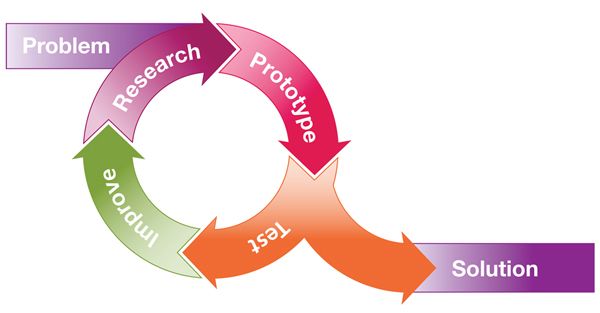My Cart
Your Shopping Cart is currently empty. Use Quick Order or Search to quickly add items to your order!
Scott W. Eddleman
Director of Product Development and Innovation
September 2016
Engineers apply science, technology, engineering, and math (STEM) in order to design solutions to problems. Activities in which students play the role of engineers in a design challenge are an exciting way to grab their attention and foster a need-to-know mindset. This article provides a planning tool you can use to integrate principles of engineering and problem-solving into your science curriculum through a design challenge.
A great way to guide your students through an engineering activity is to structure it around the engineering cycle, also known as the design process. A simple version of the engineering cycle is shown below. When teaching this process to your students, emphasize that engineers don’t always start at the beginning of the cycle and that it’s often repeated several times to improve a design.

Choose a standard to develop your challenge around. The example presented here uses a performance expectation from the Next Generation Science Standards* (NGSS). Like the example here, many of the NGSS performance expectations require students to engage in engineering practices such as designing and refining devices.
Example:
| HS-PS3-3. Design, build, and refine a device that works within given constraints to convert a form of energy into another form of energy. Dimensions of this performance expectation include: Science and Engineering Practices: Constructing Explanations and Designing Solutions Disciplinary Core Ideas: PS3.A: Definitions of Energy Crosscutting Concepts: Energy and Matter |
The question should be relevant and interesting, and it should tie the science content to an engineering problem for your students to solve. Here’s an example that follows the standard in step 1. In this example, the toy car transforms solar energy into kinetic energy.
Example:
| How can we use energy from the sun to move a toy car as fast as possible? |
Use the problem from step 2 to create a design challenge to engage your students. Identify the criteria and constraints for the design challenge. Criteria are the standards the design must meet in order to be successful. Constraints are limits related to the design and include materials, costs, and dimensions.
Next, gather the materials you wish to use for the design challenge. You may want to provide students with a limited amount of each material for their initial prototype, and then allow them to choose additional materials to refine their initial design.
Example:
|
Using the materials provided, build a solar-powered car that travels the length of a track at the fastest speed in the class. Materials include: DC motor, solar cell, 4 wheels, 2 plastic gears, axles, cardboard, glue, tape |
Identify the concepts and skills your students should have to be equipped for success. Then, decide how you will use the design challenge to address the standard you chose in step 1. You can take an inquiry-based approach by providing students with minimal science background before diving into the design challenge. Then, use the experience to teach the science concepts. Another approach is to have students build and test their prototype, and then help them apply science concepts to improvements in the initial design. Below is an example sequence of activities for the solar car design challenge.
Example:
|
Carolina offers a line of affordable kits that do the work of planning a design challenge for you. Each kit is designed to address NGSS through the lens of engineering. The activities in each kit follow the engineering cycle and are structured as follows:
Research. Students are presented with an engineering problem or technical challenge, highlighting and identifying science concepts and skills relevant to potential solutions.
Prototype. Students build a prototype device or system that will serve as the basis for further testing and study.
Design Challenge. Students brainstorm ways to modify their prototype to meet the given challenge. Then, they implement and test their designs, making modifications and improvements on the basis of their observations and data. Design challenge scoring rubrics are provided for judging the success of each group’s design and for comparing the designs of different teams.
Assessment. Students reflect on what they learned and present their findings to the class. A grading rubric is provided for evaluating each team’s performance on the assigned tasks.
*Next Generation Science Standards® is a registered trademark of Achieve. Neither Achieve nor the lead states and partners that developed the Next Generation Science Standards were involved in the production of, and do not endorse, these products.